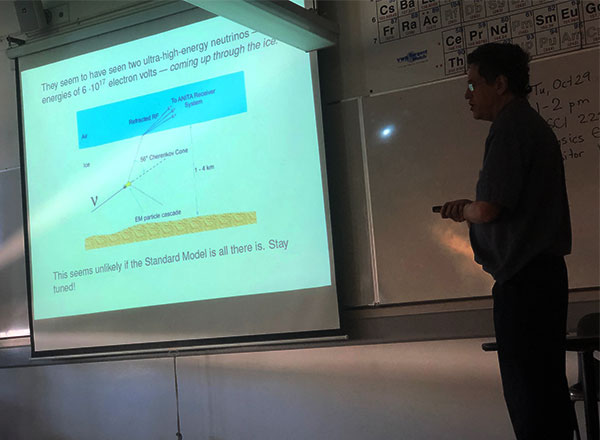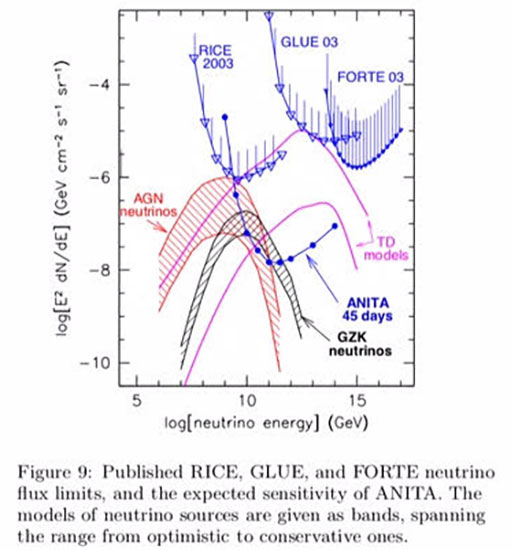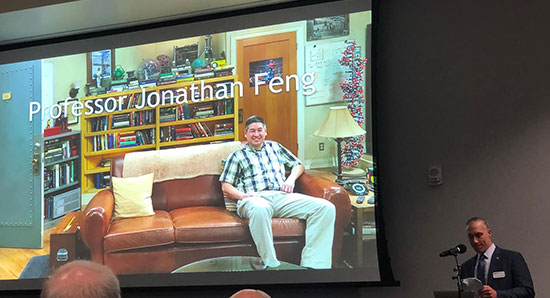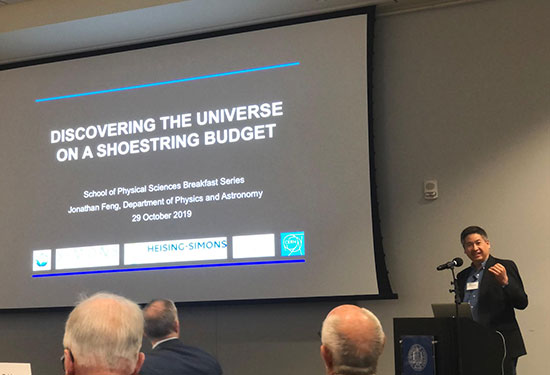Well this week the blog is all about physics so you astronomical observers buckle up and get ready for the ANITA experiment looking for high energy neutrinos and FASER experiment searching for dark matter exiting the proton beam at the LHC. Our next scheduled observing run is for the Transit of Mercury on November 11, so stay tuned for that and hope for clear skies.
First up is Professor John Baez, Mathematical Physicist at UCR, who also just happens to be cousin to singer Joan Baez, spoke at the CSULB Physics Colloquium on the "Unsolved Mysteries of Fundamental Physics."
 |
| Mathematical Physicist, John Baez, UCR speaks at CSULB Physics Colloquium (Source: Palmia Observatory) |
John is in the Mathematics department at UCR and considers himself as a mathematical physicist. His primary emphasis is the mathematics and he sort of said something about Quantum Field Theory (QFT) as a very successful physics theory but in pretty bad shape mathematically. There are some mathematical issues that need to be cleared up but the physical description does a very good job of predicting the outcome of experiments. But there are still some big issues like the incompatibility between the well proven general relativity and the also well proven standard model of particle physics. This is still one of the mysteries of physics and how the two domains will be integrated remains an ongoing research program.
Before discussing these two separate domains of physics, he started off with the types of questions that physics can answer and that sometimes asking "why something happens" is a legitimate form of questioning. Why is the sky blue, for example, can be answered in terms of atomic physics. Eventually, if you keep asking questions long enough, you can get to a point where physics cannot go any further, but at this point we can begin to see where further study into the fundamentals of physics is called for.
In his description of these two domains of physics, John presented a simple example of general relativity, one that I had never heard of before, which asked us to consider a freely falling ball of test particles. Calculating the trajectory of these particles can be easily done by considering the pressure from all of the particles and the mass density of all of the particles. Once this is done in general relativistic terms, the volume of the ball of particles can be calculated. I had not heard of this example before and really liked the simplicity of how much of general relativity, and of expansion of the universe, for example, comes out of this simple example.
 | |
|
 |
| Professor Baez asks why 25 measured constants are needed in the Standard Model? (Source: Palmia Observatory) |
So, what to do? Professor Baez explained that he had hoped that loop quantum gravity would eventually be able to integrate general relativity and quantum mechanics but that he has become disillusioned with that possibility and has gone one to put more emphasis in other areas of physics.
He did encourage us to not give up hope though in that new experimental evidence is arriving daily and we continue to make progress. One new experiment, ANITA, has reported some possible discrepancies in the SM of high energy neutrinos. He didn't explain any more about it, but said to stay tuned.
 |
| Even though GR and QFT are very successful, new data could show need for new physics (Source: Palmia Observatory) |
So we had a great review of the unfinished mystery of how to integrate QM and GR and whether or not we can find a reason for the values of the 25 measured "constants". Thanks for that Professor Baez!
But, for our homework, let's dig a little deeper and understand what the ANITA experiment is all about? ANITA is short for Antarctic Impulsive Transient Antenna, is a balloon launched radio telescope that detects radio emissions generated in the ice by interaction with a neutrino. I had not heard of this experiment and want to dig deeper. Check out the science overview shown below.
 |
| ANITA listens for radio from neutrino cascade in ice at the south pole (Source: www.phys.hawaii.edu) |
In this next picture you can see the ANITA telescope being transported and readied for balloon launch. The telescope has 40 horn antennas, arranged symmetrically around a common structure, and is designed to receive and measure polarization of signals in the 0.2 to 1.2 GHz range.
 |
| Getting ANITA ready for balloon launch in Antarctica (Source: www.phys.hawaii.edu) |
The signals are the result of neutrino generated electron cascades in the ice. This effect, called the Askaryan effect, which generates a coherent radio pulse along the Cherenkov light cone associated with the cascade of particles. The details are pretty complicated but the following graphic shows some of the details.
 |
| ANITA measures coherent radio waves caused by Askaryan effect from neutrino interactions (Source: www.hep.ucl.ac.uk) |
Some of the published papers show the increase of sensitivity of ANITA over previous attempts at measuring the coherent radio emissions. With this new level of sensitivity it becomes possible to constrain some of the predictions of the Standard Model. I don't yet understand how this new data puts some portions of the standard model at risk and we will have to leave that issue for later. Stay tuned.
 |
| ANITA has higher sensitivity than previous experiments (Source: ANITA Collaboration, arXiV:0503304v1) |
Finally, physics topic number 2 comes from the UCI Physical Sciences Breakfast Lecture Series. The breakfast lectures are free, except for parking. This breakfast lecture series was introduced by the new UCI Physical Sciences Dean, Dr. James Bullock. The speaker this morning was Professor Johnathan Feng, UCI, whose diagram for the FASER (Forward Search Experiment) was shown on the blackboard of the TV series "The Big Bang Theory" and in the introductory slide we see him seated in Sheldon's spot on the couch. Later in his talk, he joked that the FASER concept had the approval of two of the leading physicists in the modern world! Who were the physicists you ask? Well, of course, Leonard and Sheldon!
 |
| New UCI Physical Sciences Dean, James Bullock, introduces breakfast speaker (Source: Palmia Observatory) |
 |
| Jonathan Feng speaks about the FASER experiment at UCI Breakfast Lecture (Source: Palmia Observatory) |
The FASER project is based on the recognition that at the LHC, major portions of the energy and particles released from the point where the two proton beams collide, does not pass out perpendicular to the proton beam, as most of the detectors and experiments built there are designed to detect, but in actuality pass out aligned with the direction of the proton beams. Now you cannot put another experiment directly in the path of the beams, but what FASER intends to do is to place its detector tangent to the proton beams. The proton beams travel essentially in a circle and the results of proton collisions then travel and emerge from that point tangentially to the circle. After reviewing drawings of the LHC, the FASER team recognized that there was already an unused service tunnel were they could place the FASER detector and not interfere with LHC operations and nevertheless intersect the very intense beam of generated particles that travel tangentially from the proton beam, through a hundred meters of dirt and concrete, mostly unimpacted, and arrive at the FASER detector. Pretty neat! If you want to see more of the technical details, check out the paper referenced in this blog's previous post about FASER of April 28, 2019.
So what the FASER team is able to do is conduct new particle physics experiments on a shoestring budget and explore a domain of particle energy and interaction strength that no other accelerator can do. In the slide below, you can see that the LHC operates in the particle landscape near the upper left hand corner. FASER, because it has access to such a high flux beam of generated particles can then examine new physics along the diagonal domain in the slide below. Professor Feng cannot say for sure that some new particle resides in that portion of the particle landscape, but that with FASER that portion will now be observable. It s in this portion of the landscape that dark matter particles could be hiding. The characteristics of the dark matter particle, while not known, must be such that the mass meets the observed gravitational effects of large scale structure, while at the same time not decaying so quickly as to have all decayed away over the current 13.8 billions years of the universe.
The LHC is shutdown now for a long period of maintenance and upgrades and during this time the FASER team is scrambling to get funding to complete the design, fabrication and installation of the new detector in time for the startup of the LHC in 2021 timeframe. FASER is thought to be completely doable with just a couple of million dollars budget and a small collaboration team of under 100.
 |
| Professor Fend explains new domain of the particle landscape explorable by FASER (Source: Palmia Observatory) |
Until next time,
Resident Astronomer George
Be sure to check out over 300 other blog posts on similar topics
If you are interested in things astronomical or in astrophysics and cosmology
Check out this blog at www.palmiaobservatory.com

No comments:
Post a Comment